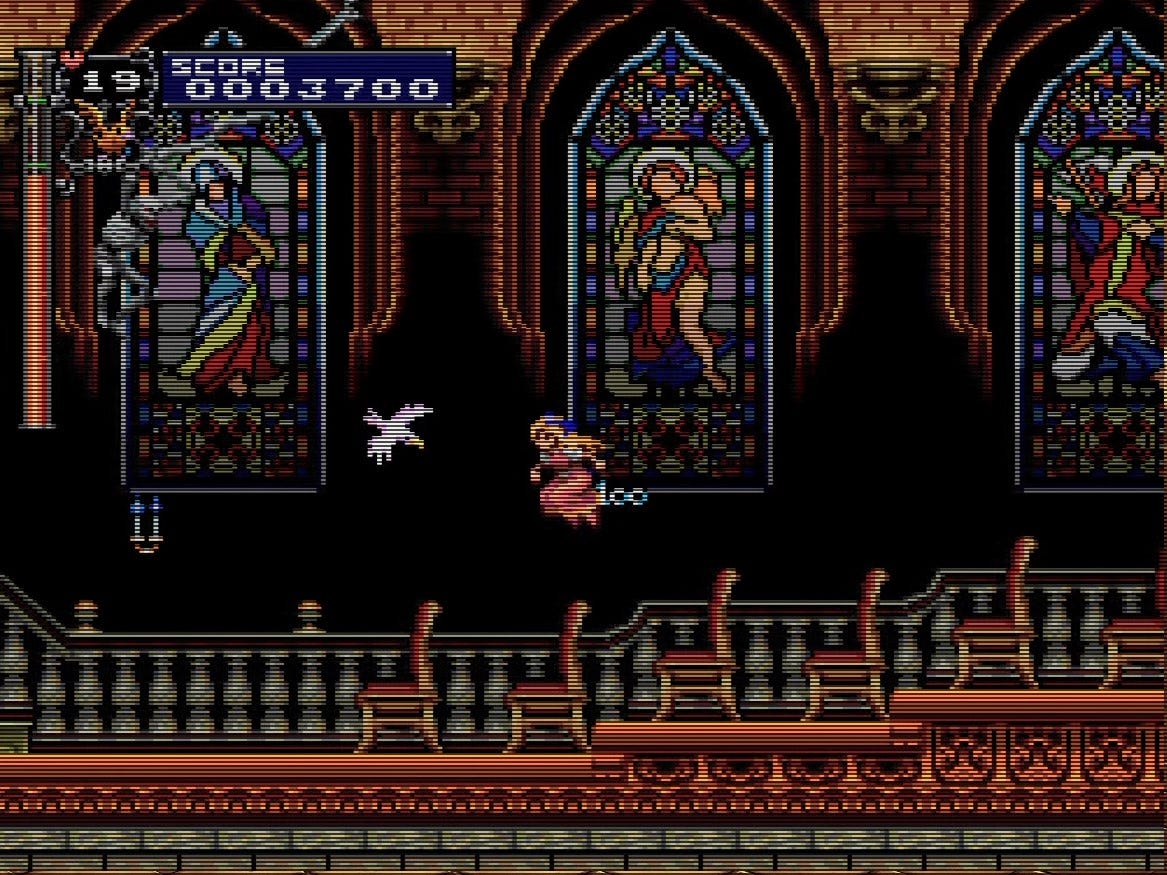Daily Dracula X - About Maria Renard
"I'm Maria Renard... vampire hunter!"
It was originally my intention to discuss Maria as part of the Stage 2 post, but she’s much too important an element to cram into a sidebar. The character of Maria is not just a welcome bit of comic relief; she represents a major bridge between Castlevania’s past and its future.
In Stage 2, you can rescue little would-be vampire hunter Maria Renard, at which point she becomes a playable character. Richter laughs Maria off at first, thinking she’s in over her head trying to kill a reincarnation of an ancient evil… But here’s the real joke:

Maria is stronger than Richter.
Maria doesn’t just have one advantage over Richter, she has every advantage and no drawbacks. Contrary to Richter’s strict jump angle, Maria can move freely in the air and even double-jump, allowing her to access places that Richter can’t, fly through areas where he struggles, and even skip entire areas.

Her main weapon— a pair of birds1— hits harder and faster than Richter’s whip; it can even boomerang enemies and hit them twice. Her sub-weapons, particularly the cat, make short work of any other enemy she’ll run into. She even has a secret move that obliterates bosses.
Maria can kill Dracula himself in one minute flat.
You’ll still have to play relatively carefully as Maria— she can’t take as much damage as Richter, and stages like 5’ and 6 are punishing no matter what— but Maria’s raw power more than outweighs her slight HP deficiency. Situations which for Richter require careful navigation are simply trivial for Maria.
Maria functions both as an alternate playable character and as an easy difficulty for a game that can be cruelly difficult.2 You are not penalized in any way for playing through the entire game with Maria, nor are you rewarded or praised for deliberately taking the hard path and continuing to use Richter all the way through.3
Maria herself represents a major transitional step between the treacherous obstacle-course crawling of classic Castlevania and the free-form exploration introduced from Symphony onwards.
Breaking entirely free of the restrictive Belmont controls and sub-weapons opened the door for the character of Alucard, who slides oh-so-smoothly in every direction on the screen, and who wields whatever weapon he can get his hands on.
Rondo of Blood doesn’t have an experience point system— a way for the player to get so powerful they can kill anything in the game instantly— but Maria is already so powerful that she makes the game a breeze.
Just like Rondo players can choose a weak character who calls for a lot of technique or an overpowered one who crushes the game by force, Symphony players can choose to stay at a low level and face a challenge or level up, get the best equipment, and steamroll the game. It’s the same principle.
I beat every stage with both characters during my “research” runs for this newsletter, but we’ll primarily be sticking with Richter throughout. The purpose of this newsletter is to discuss the game design by breaking down the levels. It’s more interesting to do that using a character who’s forced to engage with the game, rather than one who can skip a large chunk of it.
After all, reader… you’re not the one who has to play the game, and I can handle it.
Next time we’re going to get back into the game, moving into Stage 2’ (note the apostrophe), the first of Rondo’s many alternate stages, just a little bit tougher than its non-apostrophed counterpart. See you then, vampire killers!
Vampire Survivors players: While of course all the weapons are from the Castlevania series, this is one of the more obscure sources. ↩
The titles of these posts are mostly the titles of the stages when you play as Richter: the subheadings are the titles for Maria. ↩
Arguably, you can only see the “real” ending by beating the last level with Richter after rescuing all the captives… but surprisingly, there isn’t much of a difference between the two Richter endings. ↩



